

What Is the Ideal Weight to Sail a Laser?
Sailing a Laser is an exciting and challenging sport that requires skill, strength, and endurance. One of the most important factors to consider when sailing a Laser is your weight.
The ideal weight for sailing a Laser can vary based on several factors such as wind conditions, water temperature, and individual fitness levels. In this article, we will explore the ideal weight range for sailing a Laser.
Factors that affect the ideal weight for sailing a Laser
There are several factors that can affect the ideal weight for sailing a Laser. Let’s take a look at some of these:
Wind Conditions
Wind conditions can play a significant role in determining the ideal weight for sailing a Laser. If you are sailing in light winds, you will need to be lighter to maximize your speed. Conversely, if you are sailing in heavy winds, having more weight can help stabilize your boat and prevent capsizing.
Water Temperature
Water temperature can also affect your body’s ability to perform optimally while sailing. If the water is cold, you may need more body fat to insulate yourself from the cold water. On the other hand, if the water is warm, having less body fat may be advantageous as it can help you stay cooler and more comfortable.
Fitness Level
Your fitness level plays an essential role in determining your ideal weight range for sailing a Laser. If you are physically fit and have good muscle mass, you may be able to sail effectively with more bodyweight than someone who is not as fit.
The Ideal Weight Range for Sailing a Laser
The ideal weight range for sailing a Laser varies depending on individual factors such as height, fitness level, and experience level. However, on average, most sailors find that they perform best when they weigh between 150-170 pounds (68-77 kg). This weight range is ideal for most wind conditions and water temperatures and allows for optimal speed and maneuverability.
In conclusion, the ideal weight range for sailing a Laser can vary based on several factors such as wind conditions, water temperature, and individual fitness levels.
8 Related Question Answers Found
How much should you weigh to sail a laser, what is the minimum weight to sail a laser, how far can you sail a laser, how hard is it to sail a laser, how much does a new laser sail cost, how fast can you sail a laser, is it hard to sail a laser, what size is a laser sail.

Emma Gibson
- 1 Introduction
- 2.1 The Laser 4.7 / ILCA 4…
- 2.2 The Laser Radial / ILCA 6…
- 2.3 The Laser Standard / ILCA 7…
- 3.1 Hull Specs:
- 3.2.1 Laser Standard / ILCA 7 Rig
- 3.2.2 Laser Radial / ILCA 6 Rig
- 3.2.3 Laser 4.7 / ILCA 4 Rig
- 4 The International Laser Class Association
- 5 The Laser Sailing Community
- 6 The Appeal of Laser Sailing
- 7 The Future of Laser Sailing
- 8 Conclusion
Introduction
The Laser Dinghy, a one-design racing sailboat, was designed by Bruce Kirby and unveiled to the public at the 1971 New York Boat Show. Since then 200,000+ Lasers have been built to date and are sailed across 140+ countries, with its popularity being primarily due to its simplicity and performance.
The original concept for the Laser centered on creating a boat that was easy to build, sail, and purchase, thereby making it accessible to a broad range of sailors. The Laser quickly gained popularity and became the boat of choice for many sailing schools and clubs worldwide. It also rapidly gained recognition as a racing boat and debuted as the single-handed open-class dinghy in the 1996 Olympic Games.
Racing is very competitive due to the one-design restrictions, which means sailors are truly able to test their ability, rather than rely on differences in hull shape, sails, and other gear to gain an advantage.
Besides being used for competition, the Laser is a popular choice for recreational sailing. You can spot these dinghies on lakes, rivers, and oceans worldwide. With its one-design nature, ease of use, and practicality, the Laser Dinghy is set to remain a popular sailboat for many years to come.
The Laser Dinghy – 3 Sailboats In 1

The laser dinghy comes in 3 rig sizes:
- 4.7 / ILCA 4
- Radial / ILCA 6, and
- Full/Standard / ILCA 7 rig
This means that sailors of just about any ability or age can enter the sport, and advance with minimal cost.
Rigging is easy using a sleeved sail over a mast with no stays, and can be launched and sailed single-handedly with ease. Minimal parts mean minimal breakages and maintenance.
The Laser 4.7 / ILCA 4…
utilizes a smaller sail than the Standard rig (4.7m 2 / 50.6 ft 2 which is 33% smaller) and a shorter pre-bent lower mast section. It is ideal for lighter sailors (up to 121lb / 55kg) and beginners.
The Laser Radial / ILCA 6…
uses a smaller sail than the Standard rig (5.76m 2 / 62 ft 2 which is 18% smaller) and a shorter more flexible lower mast section. It is suitable for sailors between about 121lb – 154lb / 55kg – 70kg. The Radial is the most popular class of Laser, as it is suitable for the largest amount of people, including youth, women, and masters. The radial sail can easily be identified by the sail cut in a radial pattern emanating out from the clew.
The Laser Standard / ILCA 7…
has a 7.06m 2 / 76 ft 2 sail, and is more suitable for sailors above about 143lb / 65kg. This rig is suited to heavier sailors in windy conditions where weight, strength, and fitness are critical.

Summary of Key Laser Dinghy Specifications
Hull specs:.
- Length overall (LOA): 4.23m / 13ft 10.5in
- Length waterline (LWL): 3.81m / 12ft 6in
- Beam: 1.42m / 4ft 8in
- Hull Weight: 57kg / 125lb
Laser Sail Area Specs:
Laser standard / ilca 7 rig.
- Sail area: 7.06m 2 / 76 ft 2
- Luff: 5.13m
- Leech: 5.57m
- Foot: 2.74m
Laser Radial / ILCA 6 Rig
- Sail area: 5.76m 2 / 62 ft 2
- Luff: 4.56m
- Leech: 5.01m
Laser 4.7 / ILCA 4 Rig
- Sail area: 4.70m 2 / 50.6 ft 2
- Luff: 4.09m
- Leech: 4.54m
- Foot: 2.48m

The International Laser Class Association
The International Laser Class Association (ILCA), a global organization with regional sites, governs the Laser class of sailboats. The organization is responsible for developing and enforcing the class rules, which ensure that all Laser boats are built to the same specifications and are eligible to compete in official Laser regattas. The Laser Class Association also organizes and oversees major regattas and championships, including the Laser World Championships and the Laser Masters World Championships.
Membership in the Laser Class Association is open to anyone who owns or sails a Laser boat. Members have access to a wide range of benefits, including access to official class materials and publications, as well as opportunities to compete in official Laser events. The Laser Class Association also offers support and guidance for sailors who are interested in organizing their own Laser regattas.
The Laser Class Association plays a vital role in promoting and supporting the Laser class of sailboats and is a great resource for anyone who is interested in Laser sailing.
The Laser Sailing Community
The Laser sailing community is a vibrant and passionate group of sailors who share a deep love for the sport. From beginners and avid enthusiasts to professional athletes, this global community is bound by a common bond – the thrill of sailing the Laser. As one of the most popular sailing classes worldwide, Laser sailors come from diverse backgrounds, cultures, and age groups, united by their shared passion for the sport.
Laser sailing’s popularity extends across various regions, making it a truly international phenomenon. From the shores of Australia to the coasts of Europe, and the lakes of North America, the Laser class has a widespread following. Its appeal lies in the boat’s versatility, allowing sailors to compete in a wide range of sailing conditions, from challenging regattas to more relaxed lake racing. This popularity has fostered a thriving competitive racing circuit, attracting skilled sailors to local, national, and international events.
One of the most cherished aspects of the Laser sailing community is the camaraderie and sportsmanship among its members. Whether on the water competing fiercely during races or on shore sharing stories and experiences, Laser sailors exemplify a strong sense of friendship and mutual respect. Sailors often support and encourage each other, both in victory and defeat, creating a welcoming and supportive atmosphere for newcomers and seasoned sailors alike. The camaraderie extends beyond the racecourse, with events often turning into social gatherings where lifelong friendships are forged.
In the Laser sailing community, it’s not just about winning races; it’s about being part of a global family that shares a profound connection to the sea and the sport of sailing. The sense of unity and passion that emanates from this community is what makes Laser sailing not just a sport but, for many, a way of life. Whether you’re an aspiring sailor or a seasoned competitor, joining the Laser sailing community opens doors to an unforgettable journey filled with exciting challenges, lasting friendships, and the sheer joy of sailing.
The Appeal of Laser Sailing
Laser sailing offers a unique and attractive experience that captivates sailors of all levels. Its versatility, simplicity, and accessibility make it an ideal choice for both beginners dipping their toes into sailing and seasoned sailors seeking thrilling challenges on the water. The statement “It’s easy to learn but hard to master” describes it well and explains why it is so popular.
At the heart of Laser sailing’s appeal is the boat’s remarkable agility and responsiveness. The Laser’s lightweight hull and sensitive controls allow sailors to feel intimately connected with the water, empowering them to navigate with precision and grace. Whether cruising around or pushing the limits on a windy day, the Laser promises an exhilarating experience for all.
For those of us who are a bit more competitive, Laser sailing provides an unmatched thrill. The class’s popularity in local and global racing circuits opens up a world of exciting opportunities to test skills and compete against fellow enthusiasts. From local club races to prestigious international events, including the Olympics, the thrill of competitive Laser events creates an unforgettable sense of camaraderie and accomplishment that drives sailors to continually seek new challenges on the racecourse.
The Future of Laser Sailing
The Laser class continues to evolve with recent developments and potential future advancements. Technological innovations and advancements in materials are constantly being explored to enhance the boat’s performance while maintaining the strict one-design principle. As the class adapts to new challenges and opportunities, it remains committed to preserving the essence of Laser sailing – simplicity, accessibility, and competitive racing.
The Laser sailboat’s enduring popularity among sailors worldwide ensures that its future remains bright. With a strong and dedicated global community, the class continues to attract sailors of all ages and skill levels. The appeal of Laser sailing lies not only in its exciting on-water experiences but also in the lasting connections and friendships forged within the community.
As a class that thrives on inclusivity and camaraderie, Laser sailing’s relevance is poised to endure for generations to come. As new sailors discover the joy of Laser sailing and experienced sailors continue to push their boundaries, the future of Laser sailing remains a vibrant and promising one.
The Laser sailboat’s rich history, innovative design, and enduring popularity have solidified its place as one of the most beloved sailing classes worldwide. From its humble beginnings to becoming an Olympic icon, the Laser’s impact on the sailing world is profound, inspiring countless sailors to take to the waters and embrace the thrill of the sport. Its versatility, agility, and competitive edge make it a vessel of choice for sailors of all levels, from enthusiastic beginners to seasoned professionals.
As you dive deeper into the exciting world of Laser sailing, I invite you to explore further content on this website. Discover more about Laser sailing and the thriving global community that shares your passion. Whether you’re looking to purchase your first Laser dinghy , fine-tune your racing skills , or simply immerse yourself in the beauty of sailing, the Laser class promises a journey filled with excitement, camaraderie, and boundless possibilities. So, let’s celebrate the joy and passion of Laser sailing together.
Previous: Laser Sailing FAQ
Next: How To Learn To Sail
34 Comments
I am switching my boat from sailing 470 to sailing a laser now. I intend to sail laser primarily to qualify for the Olympics.
My question is if my height is good enough to sail laser standard. My height is 167 cm (5 ft, 6 inches) and weight is 68kgs.
Thanks, Vincent
Hi Vincent. Thanks for your question. I would say that at 167 cm and 68kgs, you would be at the lighter/shorter end of the scale for sailing a full rig laser. You may be able to put on some bulk before the next Olympics to handle it a bit easier. I think everyone has different opinions on what is the ideal weight for a laser. A lot depends on the conditions and your skill. Just for your info, I did some research on stats for Australia’s gold medalist at the 2012 London Olympics Tom Slingsby. He was reported to be 83kg & 186cm at the time. Good luck with it, and all the best. Brendan
My Grand daughter would like to switch froom sail Terra to Laser. What is the minimum height for the class
Hi Norman Thanks for your question. I’m not sure that there is a minimum height. It’s more about the weight. For a Laser 4.7, the ideal weight is around 110-130 lbs (50-58 kg). Any lighter and she may have trouble keeping it flat in a breeze. cheers Brendan
Hi, I am looking to buy a laser and am 5ft 10 (178cm) and around 68kg, I sail in a harbour so short chop is the worst condition, do you think I’m big enough for a standard?
Hi Giles I don’t think it’s as much about the height as it is the weight. At 68kg, you might be a little on the light side for a full rig. But it depends on how windy it tends to get also. If it’s generally pretty windy, you might struggle, but if it’s often fairly light, you may be ok. This thread has a good discussion on the ideal weight for laser standard sailor. Hope that helps. Brendan
Hi My sea scout troop has taken possession of a Laser 2. It lacks a suit of sails and a rudder. talking to others, no one is sure if the rudders are identical to Laser 1’s. Can you advise?
Hi Pete Thanks for your question. I am not very familiar with the Laser 2, so did some research. However, it was very hard to come up with information on the Laser 2 specs. From what I could tell, the rudders are different between the Laser & Laser 2, however, I was not able to find the actual specs on the Laser 2 rudder. For a measurement diagram for the Laser rudder, click here (click on the “Mast Top Section, Boom and Foils” tab). For an image of the Laser II rudder, check this out . As you can see, it looks slightly different to that of the standard Laser rudder . Sorry I can’t be of more help than that. Maybe some other readers can provide some more info. cheers Brendan
Hello, I am 6 feet tall and weigh 53 pounds, what laser whould be good for me?
Hi Alessandro Thanks for your question. I hope you mean 153lb, and not 53lb!! Opinions vary, and it depends on your fitness and ability. If you are just starting out, you may be best suited to a Radial Laser, but you are in the overlap zone between the Radial and Full rigs. So it depends a lot on your experience and fitness. It can also depend on where you live. If it tends to be quite windy on a regular basis, then you may opt for a smaller rig. Conversely, if it’s often quieter on the water, then a bigger rig may help. I’m a few lb/kg heavier than you, and I have a full-size / standard Laser rig. I find it’s great for the lighter days, but can be a bit overpowered on the heavier days. I don’t mind though, as it just makes it more exciting when you go around the top mark. cheers Brendan
Hi I’ve just brought a laser with a radial sail but a Standard mast. I was gonna make a Radial mast out of the right alloy tube but I need the measurements. Would anyone know what is The length of a radial mast?
Thanks Kaleb
Hi Kaleb Here are the measurements for the different Laser masts for each of the top and bottom sections. cheers
How tall is the mast on the “std” Laser? I had one once and it was fun getting it into the hole on the hull! Cliff
Hi Cliff Yes, it can take a bit of getting used to, when putting the mast into the mast step. Looking at this site , the total laser mast length should be approx.: – top section (including top plug) = 3600 – 305 = 3295mm – bottom section (including base plug) = 2865mm Overall laser standard mast length = 6160mm / 20.2 ft (approx.) Hope that helps!
Hi, I am 155 cm tall and weigh 49 kg. Am I suitable for sailing a laser 4.7 or should I sail a 420?
Hi D I’m not an expert with the 420. For a laser 4.7, I think you would be a bit on the light side, but it also depends on how fit, strong, and experienced in sailing you are. It may also depend, to some extent, on where you live (some places are windier than others)… if you have a strong sea breeze every afternoon, then this may be too much.
Hi, I’m a fairly experienced optimist sailor and I need to change my class due to my age. I am 157 cm tall and I weigh 46 kg. Would I be able sail a laser 4.7? The place I live can get very windy at times. Thank you
Hi Defne I think a 4.7 should be ok, but it would depend on your experience and level of fitness. Since you say that you are a fairly experienced optimist sailor, then that will definitely help. You might struggle a bit on the windy days though. If you can, ask around your local club and try to take a 4.7 out for a spin. Let us know how you go! All the best.
Hi I sail optimists and are looking into a laser as the next boat. I weigh 122 pounds and was wondering if I should get a radial or a 4.7 rig
Hi Noah Your situation is similar to the previous comment in June, so not sure if you saw that. It depends on a few things… including how experienced you are, how fit and strong you are, and what the typical conditions are like where you sail. At your current weight, you’re probably at the lower end of the ideal weight range for a radial. But if you are young and still growing, you might want to get the radial and grow into it over the next year or so. But you might struggle a bit at 1st on the windy days. See if you can take one of each out for a spin and give it a test for yourself. Best of luck with it!
Hello I have a Laser Radial sail with a “33” number above the boat sumber. the boat number is 177137 so its not an abbreviation of that … do you know what the 33 means? Thanks!
Hi Russ I’m not sure what the “33” about the boat number would refer to. Maybe some other readers may be able to help? Sorry I can’t help more than that. All the best with it.
Hi. I am currently building an El Toro dinghy. I do not want to have to handle the full 14 foot one-piece mast. I read somewhere that you can retrofit a laser 4.7 mast and sail onto an El Toro hull. A Sabot boom is marginally cheaper than a laser 4.7 one, and I was wondering if a laser 4.7 mainsail would fit a sabot boom. Thanks!
Hi Alexander I am not an expert on sabots, but from my research… The Laser 4.7 sail has a foot of 2.48m / 8.1ft. The sabot sail has a foot of 7ft and a boom of 7′ 3″. So the sabot boom looks too short for a Laser 4.7 sail.
Can anyone please tell me in what year Laser #66750 would have been made?
Hello Steve According to research that I had done previously, it looks like sail number 66750 would have been made in 1979. See this link for more info. cheers Brendan
Hi, I have sailed Sunfish sailboats, and years ago I crewed for a friend on his J24 in PHRF races. I love the idea of excitement when I sail, but I would also like to be able I sail with a passenger. Can a Laser be sailed with a passenger for entertainment? I did not see anything about the maximum capacity of the hull. Doug
Hello Doug A Laser sailing dinghy is designed as a single-handed boat, meaning it is typically meant to be sailed by one person. However, it is possible to sail a Laser dinghy with two people, although it may not be the most efficient or optimal way to use the boat. It is only a small dinghy, so the extra weight will affect the performance. There is not much room in the cockpit for 1 person, so for 2 people, it will be even more cramped. If you just want to go out and have some fun (and you and your passenger aren’t too big), then you can probably do that. But there are many other dinghies available that are specifically designed for two-person sailing that would be a better option.
Hello, I am looking for the width of the bottom part of the mast, to design a fitting for a wind indicator. Although I have looked through many sites (including the ones linked in the comments), I can’t find the specific measurements. James
Hello James The Laser mast diameter is approx. 2.5″ or 64mm.
I holiday in Finland and have just been given a laser to use but I need a hand trolley to get it over the stones on the shore. When I had a laser before many years ago, I had a light hand trolley made with plastic tubing. Do you or anyone else have a model on how to make one? I have wheels
Hello Brian I do not have any plans or instructions, but there are a few forums that discuss how to make a homemade dolly. Check out some examples here and here . Otherwise, there are new dollies for sale. Have a look at this page for more info. cheers
Hello, I’m from Brazil, and wind conditions here in Florianopolis where I live exceeds 15 knots easily. I sailed laser for several years, stopped some time ago and want to return. I am currently 59 years old, weigh 183 lb (83 kg) and I am 5’8 (1.74m) tall, being in good physical shape and codition. The question is: which laser rig would be suitable for competing, ILCA 7 or 6? Thanks!
Hello Estevao Thanks for your question. Since you have sailed a Laser dinghy before, you know how hard on the body they can be… especially on the thighs, abdominals, arms and back. If you are fit and strong, particularly in those areas, then in my opinion, you may be fine with an ILCA 7. But an ILCA 6 might be more manageable for you.
Leave a Comment Cancel Reply
Laser Sailboat: Mastering Performance and Techniques for Success
The Laser sailboat is a popular single-handed, one-design sailing dinghy known for its simplicity and performance. Designed by Ian Bruce and Bruce Kirby in 1970, the Laser has become the world's most popular adult and youth sailboat, with over 225,000 boats in 140 countries.

The boat's versatility is a significant contributing factor to its popularity, as it can be customized for different sailors and conditions using three interchangeable rigs of different sail areas.
Laser sailboats offer both beginners and experienced sailors the joy of sailing with their user-friendly design and competitive performance capabilities .
With a strong focus on sustainability, LaserPerformance, the leading producer of Laser sailboats, actively works to minimize the environmental impact of their products through ethical sourcing and manufacturing practices.

Key Takeaways
- Laser sailboats are known for versatility, simplicity, and high-performance capabilities.
- Designed in 1970, they have become the world's most popular sailboat for both adult and youth sailors.
- LaserPerformance is committed to sustainability through ethical sourcing and manufacturing practices.
History and Development
Inception of the Laser Sailboat
The Laser sailboat, an internationally popular one-design class, was conceived in 1969 by Bruce Kirby , a Canadian designer and former Olympian. He aimed to create an innovative design that was simple, affordable, and easy to sail.
The prototype, originally called the "Weekender," was first introduced to the public in 1971 at the New York Boat Show . Its inaugural sail featured the insignia "TGIF," a reference to its early name.
The boat's simplicity and performance attracted sailors of all skill levels, and by the early 1970s, it had become a commercial success.
Laser Class Evolution
The International Laser Class Association (ILCA) was established in response to the growing popularity of this sailboat. The ILCA sought to standardize the Laser's various specifications and ensure consistency across all boats.
One of its key contributions has been the establishment of three interchangeable rigs: Standard, Radial, and 4.7 , which cater to different wind strengths and crew weights.
This adaptability has made the Laser more accessible and appealing to a broader range of sailors.
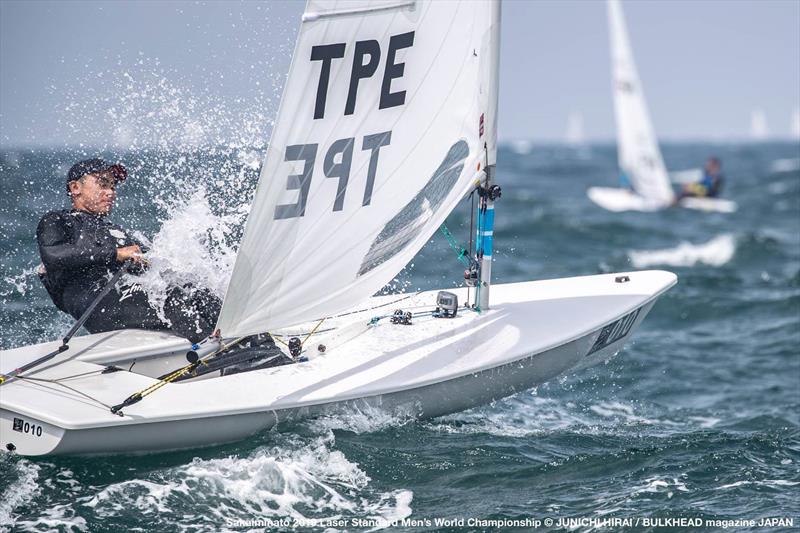
The Laser's rise as an international class was further solidified when it became an Olympic class in 1996. The boat's simplicity, strict one-design nature, and large worldwide fleet have made it a staple of the Olympic sailing program.
Its design has remained relatively unchanged since its inception, with only minor modifications being made to improve performance and durability .
The Laser remains a popular choice for sailors globally, both competitive and recreational. Its unique combination of simplicity, adaptability, and performance has ensured its continued success as a one-design class, and the International Laser Class Association continues to play a crucial role in maintaining the consistency of the boat and promoting the sport of sailing around the world.
Laser Sailboat Specifications
Hull Design and Construction
The Laser sailboat is known for its simplicity and performance which was designed in 1970 by Ian Bruce and Bruce Kirby. The hull design contributes to its stability and speed in the water.
Its construction uses a lightweight hull, ensuring optimal handling for sailors of various skill levels. This sailboat has been designed with durability and stability in mind.
Its materials and construction techniques focus on withstanding the rigors of sailing while maintaining a consistent and smooth ride on the water.
Rigging Variants
There are three interchangeable rigging variants for the Laser sailboat, each offering different sail areas to accommodate sailor weight and wind strength. These variants include:
- Laser 4.7 : With a sail area of 4.7 square meters, this rig is suitable for youth and lighter female sailors. It is considered the smallest and most accessible rig for Laser sailing. More information about Laser 4.7.
- Laser Radial : This rig offers a 5.1 square meter sail area, suited for women and lighter sailors seeking a more challenging sail size. Learn about Laser Radial.
- Laser Standard (ILCA 7) : The most common and originally designed rig using a 7.1 square meter sail, also known as MK2 , features a larger sail area suitable for heavier and more athletic sailors. Details on Laser Standard sail and rig.
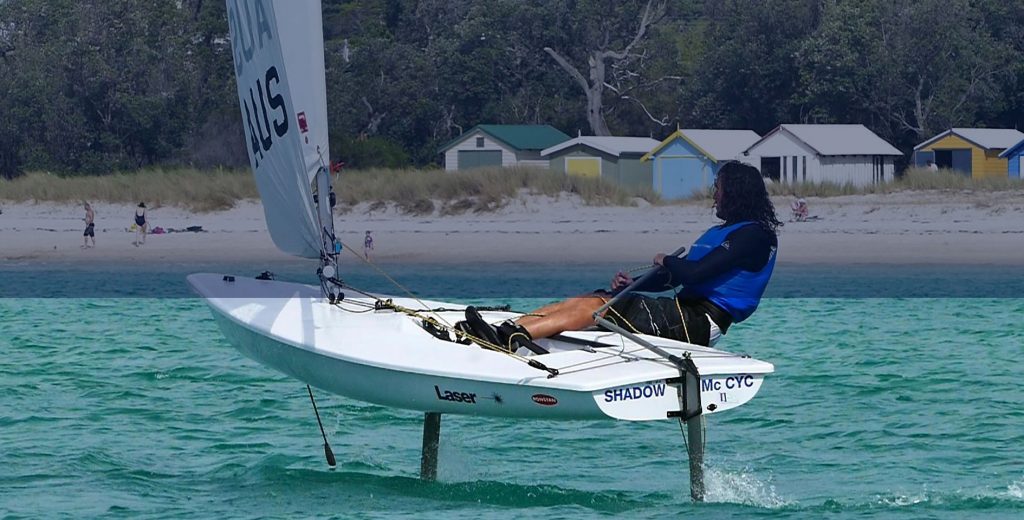
Dimensions and Sail Measurements
The Laser sailboat has specific dimensions and sail measurements which contribute to its design and performance. Here are the key dimensions:
- LOA (Length Overall): 4.2 meters
- LWL (Length at Waterline): 3.81 meters
- Beam : 1.39 meters
- Draft : 0.787 meters
- Weight : Standard 58.97 kg (130 lbs)
The sail measurements for the three different rigging variants are as follows:
| Rig Variant | Sail Area (sqm) |
|---|---|
| Laser 4.7 | 4.7 |
| Laser Radial | 5.1 |
| Laser Standard | 7.1 |
These specifications ensure consistent performance and ease of handling for sailors in various conditions and preferences.
Sailing Dynamics and Performance
Handling and Maneuverability
The Laser sailboat is known for its excellent handling and maneuverability, making it suitable for sailors of all skill levels.
Its simplified rigging and straightforward design allow for easy control and quick response to changes in wind and water conditions.
The Laser's hull weight is only 120 pounds (54.43 kg), contributing to its nimbleness on the water.
Steering the Laser sailboat is mostly dependent on the sailor's body positioning and sail trimming techniques, giving more room for tactical excellence. Due to its responsive nature, the Laser rewards sailors who can make quick adjustments and maintain an optimal sail trim.
Speed and Stability
The Laser sailboat offers a good balance of speed and stability for both recreational and competitive sailing.
Its relatively simple design, combined with a large sail area of 75 square feet (6.97 square meters) , enables it to reach impressive speeds for its size while maintaining stability.
Key factors affecting the Laser's speed and stability include:
- Hull design: The Laser's hull is designed to reduce drag and enhance stability, providing a fast and steady sailing experience.
- Sail size and shape: The Laser's sail is optimized for various wind conditions, allowing it to perform well in both light and strong winds.
- Sailor's weight and athleticism: The speed and stability of a Laser sailboat are also influenced by the sailor's weight and athleticism. An optimal weight range for Laser sailors is 140 to 190 pounds (64 to 86 kg) , and experienced, athletic sailors can better handle the boat in challenging conditions.
Sailor Interaction
A significant aspect of the Laser sailboat's performance is the level of interaction between the sailor and the boat.
As mentioned earlier, the Laser rewards sailors who possess excellent steering and trimming techniques, as well as a strong sense of tactical awareness.
This interaction allows the Laser to perform at its best under various conditions.
Sailors can further optimize their Laser sailboat's performance by:
- Adjusting the sail's angle and position to match wind conditions
- Proper body positioning and weight distribution
- Adopting efficient upwind and downwind sailing techniques
- Maintaining focus and awareness of wind shifts and changes in water conditions
Types of Laser Sailboats
Laser sailboats are a type of one-design dinghies, which means that they follow strict design and manufacturing rules to ensure all boats in the Laser class are identical.
The versatile laser class is widely popular as they offer different sail and rig sizes, catering to sailors of various ages, weights, and skill levels.
Laser Standard
The Laser Standard , also known as the ILCA 7 , is the largest of the three laser rigs. This adult racing class boat features a 7.1 sqm sail, making it suitable for heavier and more athletic sailors.
Laser Radial
The Laser Radial or ILCA 6 has a smaller 5.1 sqm sail. It is specifically tailored to lighter sailors, including women and youth sailors. The Radial's sail allows for better control and easier handling in various wind conditions.
This provides a level playing field for a wide range of sailors in terms of age, weight, and experience level.
Lastly, the Laser 4.7 or ILCA 4 features the smallest sail, measuring 4.7 sqm. This rig is designed for young sailors who are new to Laser sailing and need a more manageable sail size. The unique 4.7 lower mast section includes a pre-bend near the boom fitting, which allows the sail to depower more easily.
This provides a more forgiving experience for new and younger sailors.
Each Laser sailboat variant utilizes the same hull design, ensuring that the core sailing experience remains consistent across the board. This enables sailors to transition seamlessly between the different rig sizes as they progress in their sailing abilities.

Competitive Sailing
Racing and Regattas
The Laser sailboat has been a popular choice in the sailing community for competitive racing due to its simplicity and one-design class. The Laser Class Association organizes races and regattas in various formats where sailors adhere to the class rules.
The laser class has three different sail sizes - Laser Standard (ILCA 7), Laser Radial (ILCA 6), and Laser 4.7 (ILCA 4). These cater to sailors of different ages, weights, and abilities to participate in a single class.
These characteristics make the Laser sailboat a widely sought-after option for sailors who are interested in competitive racing 1 .
Olympic Presence
The laser class has a strong presence in the Olympics, being recognized as an Olympic class sailing dinghy. Laser Standard (ILCA 7) and Laser Radial (ILCA 6) are the two divisions that have been part of the Olympic Games since 1996 and 2008, respectively.
With its universal appeal and the level playing field it offers to sailors, the laser class has grown significantly in popularity over the years. It has achieved global recognition as a highly competitive sailing class in the Olympic Games.
National and International Championships
Alongside racing, regattas and their Olympic presence, the Laser Class Association also organizes various national and international championships.
Among these events are the ILCA 4 Youth World Championship, scheduled to happen in Viana do Castelo, Portugal, in June 2024 2 .
The World Championships typically attract top sailors from different nations, competing for the title of world champion.
A list of major championships for laser sailing includes:
- ILCA 4 Youth World Championship
- ILCA 6 World Championship
- ILCA 7 World Championship
In addition to these flagship events, many national championships are also held regularly by various Laser Class Associations around the world. This fosters the growth of talented sailors and promotes the spirit of competition within the laser sailing community.
Maintenance and Upkeep
Routine Care and Maintenance
Laser sailboats are known for their durability, but regular maintenance is essential to ensure their longevity and maintain resale value.
Inspect the hull and foils for any damage or signs of wear. Also, check the steering systems, such as rudder and tiller, ensuring they are functioning smoothly without any wiggles.
Regularly inspect tiller extension fittings for cracking and signs of potential breakage.
Cleaning your sailboat after each use will help minimize the chance of damage from dirt, salt, and debris. Store sails, lines, and other equipment properly to avoid moisture damage, mold, and mildew growth.
Verifying the functionality of the autobailer should also be a part of the routine maintenance process.
Transport and Storage
Transporting a Laser sailboat can be done with relative ease, as they are lightweight and their compact size allows for cartop transport.
When cartopping your Laser, use appropriate padding and straps to secure the boat without causing damage to the hull, mast, or other components.
As for storage, it is essential to keep your Laser sailboat in a covered and well-ventilated area, preferably on a dolly or custom cradle that supports the gunwales to prevent unnecessary stress on the hull.
Moreover, ensure the mast and other equipment are safely stored alongside the boat.
Periodically inspect the boat during storage to check for any signs of damage, moisture buildup, or rodent infestation.
Laser Sailboat Community and Culture
The Laser sailboat has built a strong sense of community that extends across different countries. This community primarily revolves around clubs, associations, and social and recreational sailing.
Clubs and Associations
A significant part of the Laser sailing community is the involvement in clubs and associations at various levels. The International Laser Class Association (ILCA) is the governing body that brings together Laser sailors from all around the world.
This association is responsible for maintaining the one-design principles, organizing international events, and promoting Laser sailing as a high-quality, competitive sport.
At a local level, numerous clubs are home to passionate Laser sailors. Club racing is a popular form of competition within the community, offering a friendly yet competitive environment for sailors to test their skills.
There are also regional associations supporting the growth of the Laser sailing community in their respective areas.
Example of Laser clubs:
- Family Fun Sailing Club : Focused on promoting sailing for the whole family and organizing social events.
- Weekender Club : Emphasizes weekend gatherings and collaborative sailing initiatives.
- TGIF Racing Club : Prioritizes Friday evening club races for those looking to engage in competitive sailing after work.
Social and Recreational Sailing
The Laser sailboat's appeal extends beyond competitive racing, with many enthusiasts enjoying the boat for its simplicity and versatility in social and recreational sailing.
The Laser community is known for organizing events that cater to various interests and skill levels, ensuring that everyone has a chance to find their niche.
Some common social and recreational sailing events include:
- Casual group sails : Informal gatherings where sailors can share tips, learn from one another, and enjoy sailing in a relaxed and social environment.
- Adventure sails : Excursions to explore new sailing locations or participate in long-distance trips.
- Family fun days : Sailing events focusing on family-oriented activities, making the sport accessible and enjoyable for all ages.
Frequently Asked Questions
What factors determine the price of a Laser sailboat?
When looking for a Laser sailboat, various factors such as brand, condition, materials used, size, and additional features all play a role in determining the price .
A brand-new Laser will typically cost more than its used counterpart. Higher quality materials and improved technology can also increase the price, as well as customizable options and additional accessories.
To find the right Laser sailboat at a competitive price , it's essential to compare offerings from various vendors and take time to evaluate factors like reputation and warranty. Sailing Chandlery provides more information on Laser sailboats and their prices.
What are the essential specifications to look for in a Laser sailboat?
When considering a Laser sailboat, pay attention to details like hull weight , rig size, sail size, and weight capacity , as these will affect the boat's performance and suitability for the intended use.
A standard Laser sailboat generally has a hull weight of 125 lbs or 56.7 kg , with different sail sizes available, such as ILCA 4 (Laser 4.7), ILCA 6 (Laser Radial), and ILCA 7 (Laser Standard).
Each sail size is designed for sailors within specific weight ranges, providing the best performance and stability.
How can I find a reputable vendor for Laser sailboat kits?
To find a reputable vendor for Laser sailboat kits, research different suppliers, seek recommendations from fellow sailors, and read reviews from previous customers.
Online platforms like West Coast Sailing offer resources and information on Laser sailboats, including detailed guides, FAQs, and where to find quality suppliers.
What is the recommended weight capacity of a standard Laser sailboat?
The recommended weight capacity for a Laser sailboat varies depending on the rig size.
The ILCA 6 (Laser Radial) is suitable for sailors between 60 kg and 75 kg , while the ILCA 7 (Laser Standard) is better suited for sailors weighing 75 kg to over 90 kg.
The ILCA 4 (Laser 4.7) is designed for younger and lighter sailors. When choosing a Laser sailboat, ensure that the rig size matches the intended user's weight range for optimal performance.
What are the characteristics that define the best Laser sailboats on the market?
The best Laser sailboats on the market offer a combination of durability, performance, and ease of use.
Look for models with robust construction. They are made from high-quality materials to withstand harsh sailing conditions.
Additionally, seek sailboats with easy-to-use rigging systems and low-maintenance designs.
Also, make sure they have support from reputable manufacturers. This ensures they meet strict class specifications.
Is sailing a Laser suitable for beginners and what are the challenges involved?
Sailing a Laser is generally suitable for beginners. These boats are known for their simplicity, ease of use, and responsive handling. However, beginners should be prepared for some challenges.
These challenges include mastering the correct body positioning and balance or adjusting to different wind and weather conditions. It's essential for new Laser sailors to familiarize themselves with the boat's assembly and rigging process and seek guidance from experienced sailors or trainers. This ensures a safe and enjoyable sailing experience.
Related Articles

Guess What Happened to Deadliest Catch's Cornelia Marie? Shocking Twist Revealed
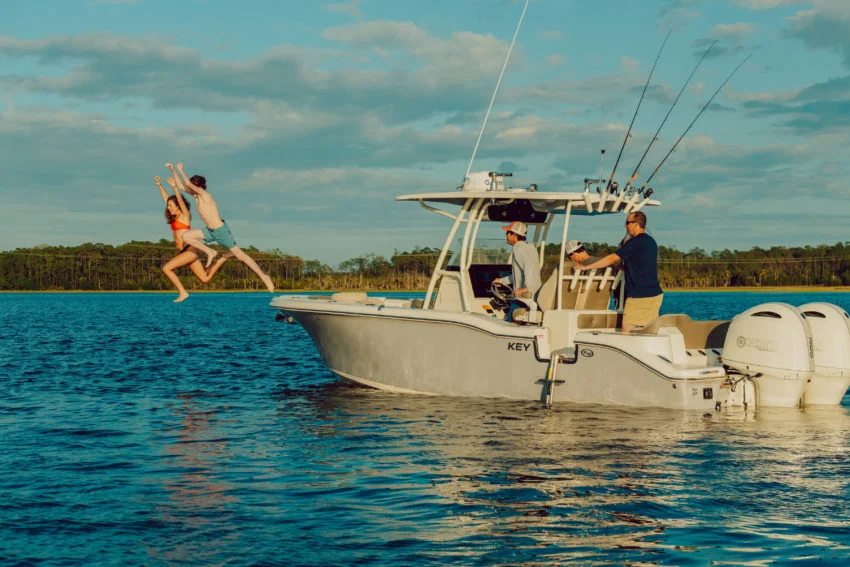
Key West Boats: Your Ultimate Guide to Top Models & Features

Bass Boat Central: A Comprehensive Overview of the Iconic Website
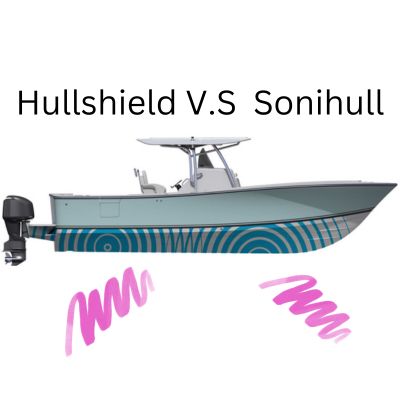
Sonihull vs Hullshield: Comparing Top Ultrasonic Anti-Fouling Systems

Deck Boat Essentials: A Comprehensive Guide for Enthusiasts
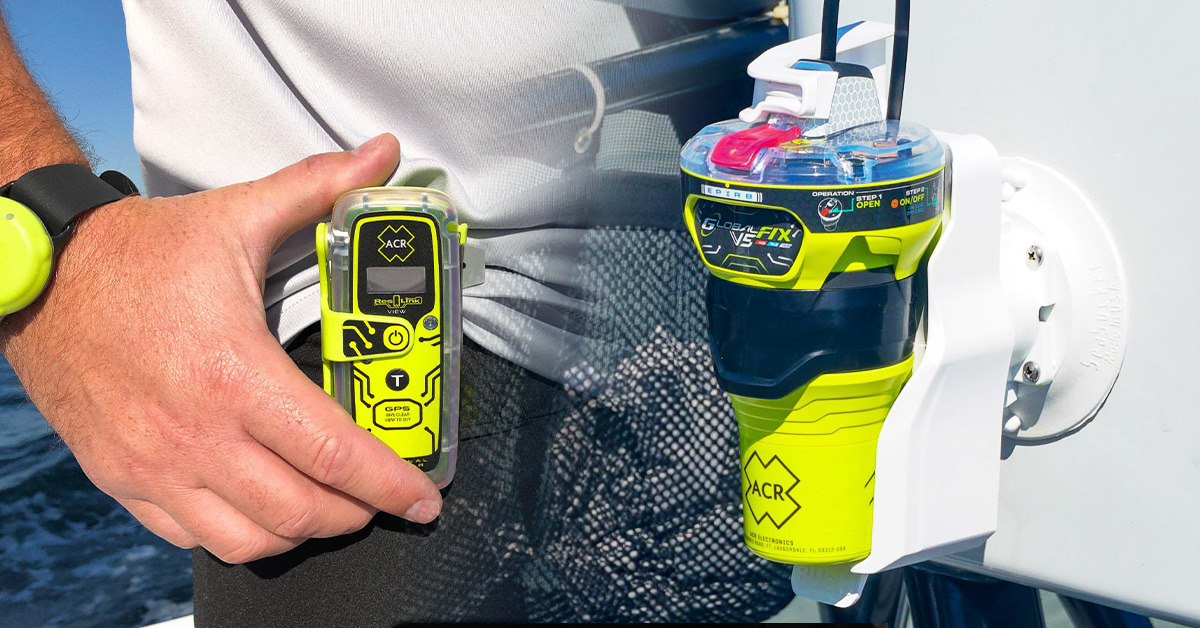
EPIRB: Essential Guide for Maritime Emergency Situations

What Do Red and Green Markers Indicate on a Boat: Essential Guide for Navigators

What Do Manatees Eat: A Comprehensive Guide on Their Diet
Your cart is empty
Have an account?
Log in to check out faster.
Best Sellers

ILCA (Laser) Sailing 101
What is the ilca (laser) class.
Note: In this article, the terms "Laser" and "ILCA" are going to be used interchangeably. Worldwide, the class is now officially known as the ILCA, despite originally being called the Laser .
The Laser class is a one design dinghy originally designed by Bruce Kirby and Ian Bruce in 1969. Although the original intent behind the design was a recreational, family-friendly boat, the Laser has gone on to become one of the most popular racing boats in the world, with over 220,000 produced.
What makes up a boat?
Being a one design and Olympic class, all Laser boats conform strictly to the Laser class rules. In order to compete at continental and international championships, you will need to ensure that your equipment is ILCA class certified, and complies with the measurement standards set out by the class. There is a number of non-class legal equipment available, and if you're just planning on sailing for fun, these are a great option for getting started. (Hint: google Intensity Sails)
A relatively lightweight hull for its size, the Laser is 4.23m long, has a beam of 1.42m and weights 57kg. All hulls are built from glass reinforced plastic (AKA fibreglass) and are known for their robust construction and light weight.
One of the unique features of the Laser class is the three different rigs which can all be used with the same hull. This allows sailors of different ages, weights and abilities to participate in a single class. The rigs are:
Laser Standard (ILCA 7)
Laser Radial (ILCA 6)
Laser 4.7 (ILCA 4)
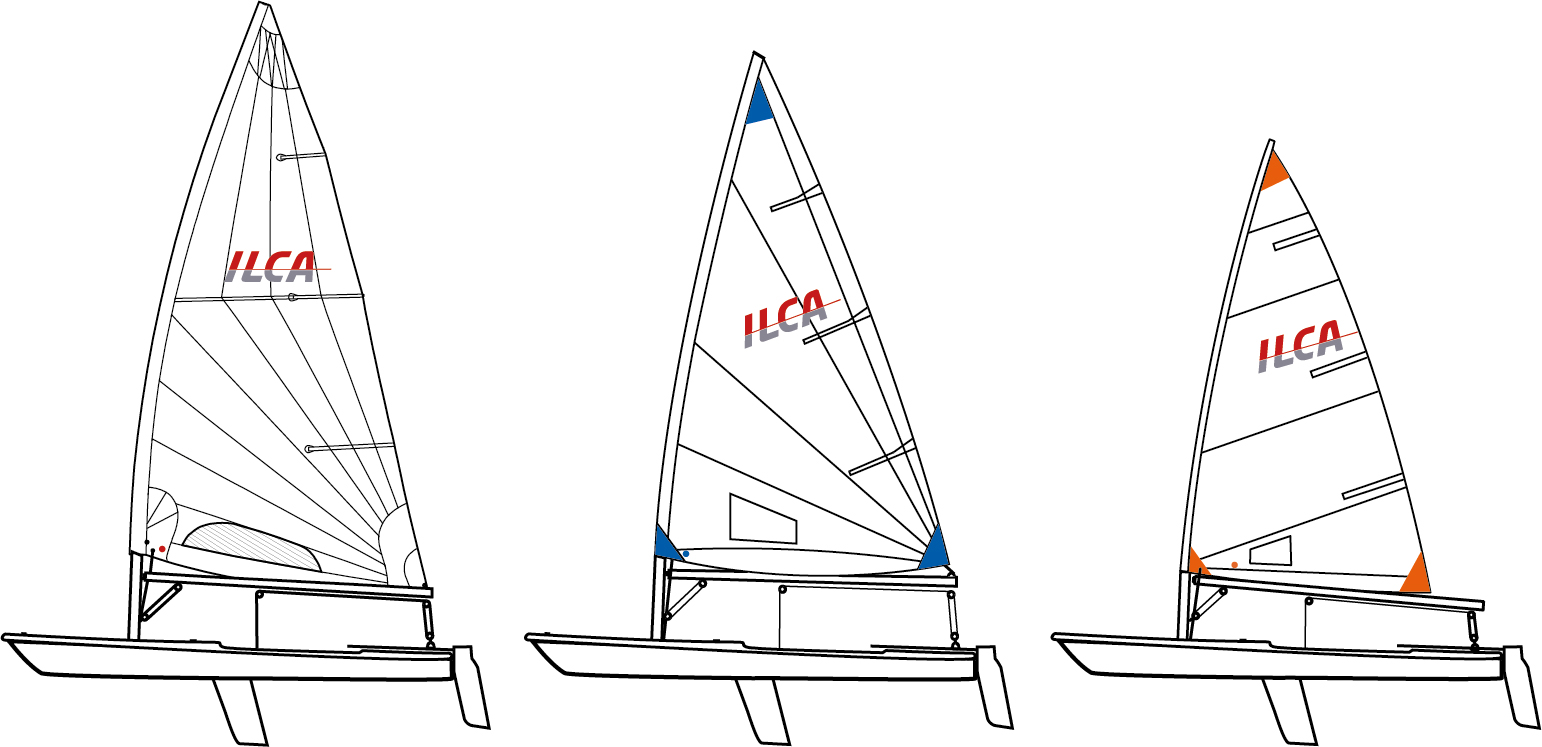
Masts/Spars
Each Laser rig consists of three pieces - the bottom mast, top mast and boom. The bottom mast is specific to each rig size, but the same top section and boom can be used with all three rigs.
Similar to the bottom mast sections, each Laser rig also has its own sail, and they are all different sizes.
Control Lines and Rigging
In the early 2000s, the class introduced the Turbo Kit rigging, which made a significant difference in the techniques and ease of sailing the boat. Although the Turbo rigging is standard nowadays, the old systems can still be found, and can be used to race.
One thing that many sailors like about the Laser is the speed and simplicity of its rigging. The boat has only four main control lines: the mainsheet, vang (kicker), cunningham and outhaul.
Similar to the hull, ILCA foils are also made from fibreglass. The centreboard (daggerboard) is inserted in to the case aft of the mast step, and the rudder clips easily on to the gudgeons on the transom of the hull.
Accessories
Launching trolley - unless you will be beaching (not recommended) or storing your boat on a dock, you will need a trolley to launch your boat. Most boats are sold with these.
Road Trailer - if you would like to sail at different venues, or compete away from home, one of the easiest ways to transport your boat is with a road trailer. The Laser was originally designed to be loaded on to the roof of a car, and if you would like to find out more about transportation methods, we have a full article here .
Tiller and Extension - these come in both aluminium and carbon varieties, and both can be used to race.
Clothing - you can wear anything while sailing the Laser, but I would recommend getting at least a life jacket (better safe than sorry), and a pair of hiking pants. Hiking pants will protect the back of your legs from the deck, and allow you to sail for longer.
Who Can Sail the Laser?
Another great things to mention about the Laser is the range of uses and abilities the boat caters to. Lasers can be sailed on the weekend with your family for fun, or raced in the Olympics and everything in between!
What is the optimal weight for the Laser?
Thanks to the three rig sizes in the Laser class, the weight range in the Laser is quite large. Generally, the Laser Radial (ILCA 6) is suitable for sailors between 60kg and 75kg while the Laser Standard (ILCA 7) is suitable for sailors 75kg to over 90kg. The Laser 4.7 (ILCA 4) is designed specifically for younger and lighter sailors with an optimal weight range between 45kg - 60kg.
What ages are the sailors?
Laser sailing is a sport you can do for life, and nearly every Laser regatta there will be an age category catering to everyone from junior sailors through to master ages. Generally the age categories are U19, Open (20-35), and Masters (over 35). Depending on the regatta, there may also be additional age divisions including U17, and U15. It’s never too late to start sailing a Laser!
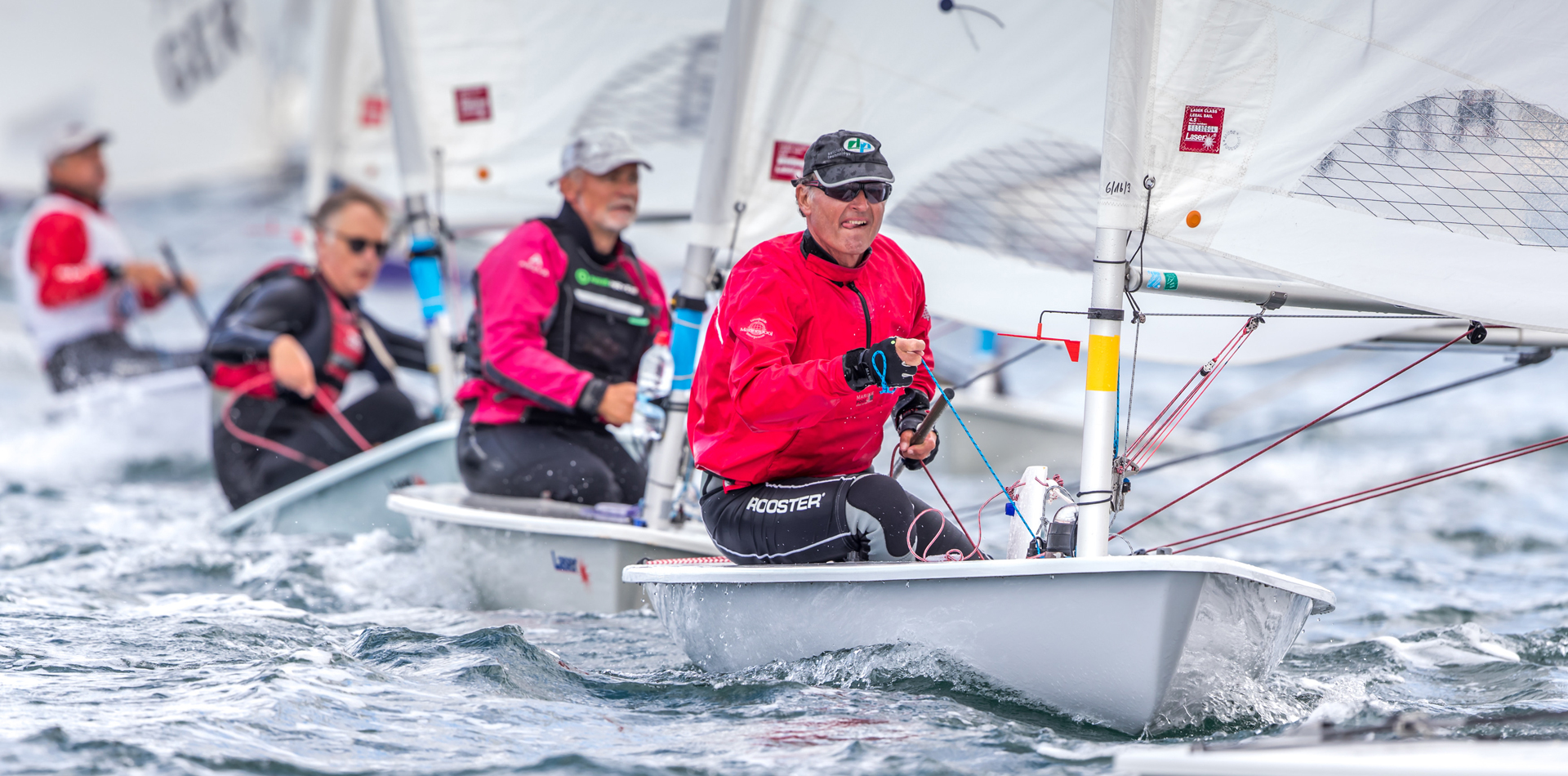
Where to Sail a Laser?
The Laser world is divided in to 6 different regions:
North America
Central and South America
Rest of World
with each region comprising of various member countries and districts. Being the most popular dinghy class in the world, there are Lasers in over 120 countries around the world, and it's likely there is a sailing club with at least one boat near you. For more information and contact details for an association in your country, ILCA have a directory of ILCA District Contacts .
Laser Racing
Since the inception of the class, the Laser has been considered one of the world's premiere racing classes thanks to its low-cost, availability and one design nature providing tight competition at all levels. Since 1996, Laser racing has been included at the Olympics, and many Olympic laser sailors have gone on to the pinnacles of high performance sailing. If you want to see the calibre of some of the sailors who have competed in the Laser, be sure to check out our ranking of the Top 10 Male Sailors and Top 10 Female Sailors of all time.
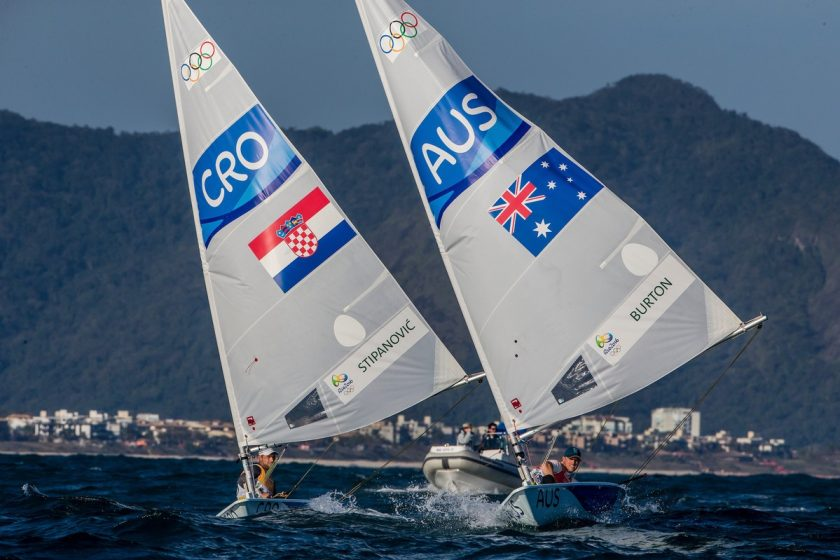
Outside of the Olympics, the ILCA class also organises World Championships for all rigs and age divisions on a yearly basis. These include the following regattas:
Masters World Championship (all divisions and rigs)
U21 World Championship (ILCA 6 and ILCA 7)
ILCA 4 Youth World Championship
ILCA 6 Women's World Championship
ILCA 6 Youth World Championship
ILCA 6 Men's World Championship
ILCA 7 Men's World Championship.

The full list and dates of upcoming ILCA World Championships can be found on the ILCA website .
Each ILCA region also hosts their own continental championships, and these also have a typically high attendance, and strong calibre of racing. The list of championships for each of the regions can be found here:
Oceania (out of date)
Starting Out with ILCA Sailing
If you're now feeling ready and excited to kick off your Laser journey, here's some things you might want to know before getting on the water
Getting a Boat
Due to their popularity, nearly every sailing club around the world will have at least one Laser lying around which you could try out before you buy your own boat. Many clubs also have rental programs where you can borrow or lease their boats for a minimal cost. This is a great way to get started and see if you enjoy the class.
If however, you're already at the point where you want to get your own boat, there will also be plenty of second hand boats which you could consider upgrading to. If you want some advice on looking for a used Laser, we have a complete second hand Laser Buyer's Guide .
Alternatively, I may have done such a good job convincing you to start ILCA sailing that you're ready to throw yourself in to it headfirst and buy a new boat. If that's the case, contact me at daniel.self@sail27 .com and I can help you find the best boat for you, or connect you with a great Laser dealer in your area.
Training and Coaching
Regardless of your ability, getting a coach is going to help you improve your sailing and much faster than you would by yourself. There are plenty of ILCA coaches all around the world, and the best resource I have found for finding a coach is ILCA's Coach directory . Another great option is to talk to your local sailing club or ILCA district association - they're sure to know someone in your area who can help you get started in the class.
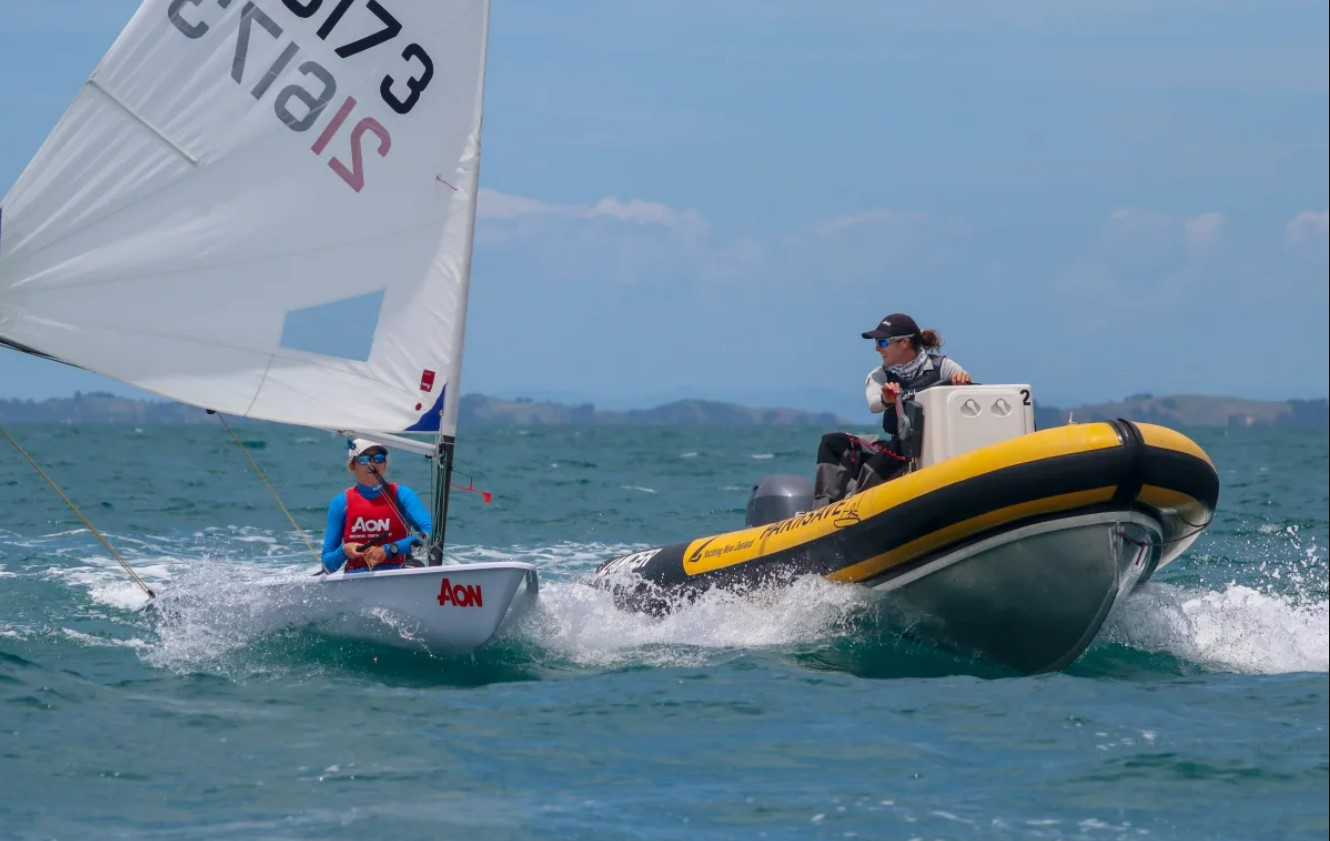
Since the COVID pandemic, online Laser coaching has become more accessible, and the guys at the International Sailing Academy have some great courses which can help you get from an intermediate to advanced Laser sailor.
You may however still be more of a 'book person' (that's how I started as well). If that's the case, I would recommend the RYA Laser Handbook. Although its a little older now, this is the most comprehensive guide to Laser sailing that I've read. Even as I got further in to my sailing journey, I would often refer back to this book for new tips.
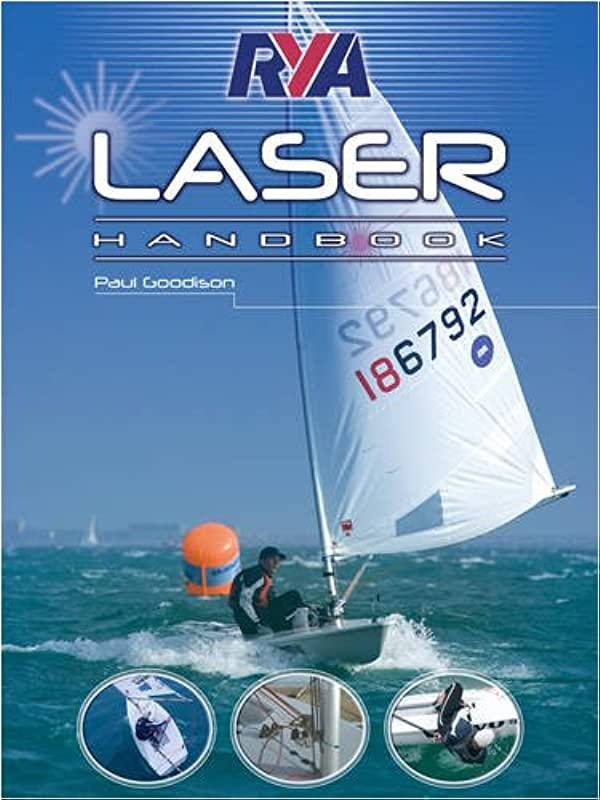
Wrapping Up
With all of that information, you should now be well versed on the ILCA class, and how you can get started in it. If you need any further information, feel free to comment below and I'll try to answer as well as possible. Otherwise, happy sailing and I'll see you on the water sometime soon!
Leave a comment
Please note, comments need to be approved before they are published.
- Choosing a selection results in a full page refresh.
- Opens in a new window.
International Laser Class Association
One Boat, One Sailor, One Design.

Fitness for Lasers
by Jon Emmett
Laser sailing is most definitely a sport. Assuming equal levels of technical skill, the fitter you are the faster you will go in medium-to-strong winds, and you definitely don’t want to be let down by your fitness.
Very broadly speaking there are three areas of fitness:
- Core (The inner muscles that support the body.)
- Strength (Think legs and arms both strong enough, with enough endurance to complete a regatta.)
- Aerobic (The ability of your heart and lungs.)
All of these can be worked on both on and off the water. A good diet and adequate rest are essential to make progress as well. In fact, many top sailors will spend longer on their “supplementary” training than they will hours on the water.
It is important to continue to train when away from home and you can have extremely effective training with very limited equipment. This is especially true with the core training. Remember, not only does a strong core protect your back from injury, but it makes your kinetic body movements to trim the boat over the waves much more effective, and therefore you a faster Laser sailor.
Training when away from home:
In recent years, cycling has been a very stable part of most Laser sailors’ fitness routines. It is a low-impact activity, which means you can do it for a long duration. It works similar muscles to hiking and it can be a lot of fun to tour all around the sailing venues. Remember many people come to Palma for example, purely for the cycling. By getting the hours in on the bikes, it increases your ability to do long hours on the water. It not only improves your ability to perform any activity that gets you out of breath, but also has a huge impact on your ability to recover from a demanding day. Something which is essential at a strong-wind regatta.
It is very important to time-table adequate rest during the day so that you have a good break between two sessions for example: cycle morning / sail afternoon, sail morning / weights afternoon, or even sail / sail so that both can be quality sessions. You also need to schedule rest days, for example 3 days on, 1 day off; 5 days on, 2 days off. Of course, this depends upon the intensity level of the day/week (the more intense the session, the more rest you need between the two sessions in the day. The more intense the days, the more rest days you need in a week). Simply training until complete fatigue is not a sensible option because illness and injury are far more likely, which would result in less training time and certainly less fitness improvement in the long term.
Gym work also helps achieve big gains in performance, especially if you need to gain weight and power, perhaps when you transition from 4.7 to Radial, or Radial to Standard rig. It is recommended that you seek the advice of a professional trainer to ensure that you lift what is appropriate for your age, fitness, and ability. Remember, good form is far more important than the exact amount you can lift, and the end goal is to be a better Laser sailor and injury-free.
Training in the gym:
Now looking at the detail of a session. A good session always starts with a warm-up whether you are sailing, lifting weights, or cycling. You shouldn’t go straight into full intensity. We are of course used to see this in other sports, and in sailing it is just as important. At the end of the session is the time to have a good stretch, to help remove waste products from your muscles and maintain or even improve flexibility. It can also be a really good opportunity to reflect on the recent training session.
Jon runs a Coach Yourself to Win page where you can find video, photos, and training tips from all the top regattas, as well as a Train to Win group where you can download NOR, Sis, Results and see FAQs on this events.

IMAGES
VIDEO
COMMENTS
ideal body weight for standard laser per wind condition. Thread starter tkjazzer; Start date Sep 14, 2008; Sep 14, 2008 #1 T. tkjazzer Member. ... she knows how to sail a laser - sailed in college (but is not a hard core sailor - was a crew [rowing] national team athlete and only sailed the season she had knee surgery) - I'm wondering if she ...
So, on the one hand we have one of the men who created the boat, and guys who were 1st (4 times, once in Radial and 3 times in big rig), 2nd and 3rd in the world saying you need to be 76 or 78 kg to sail a big rig, and on the other hand we have a company trying to sell boats to as many people in the world as they can saying you can be 60 kg.
In this article, we will explore the ideal weight range for sailing a Laser. Factors that affect the ideal weight for sailing a Laser. There are several factors that can affect the ideal weight for sailing a Laser. Let's take a look at some of these: Wind Conditions. Wind conditions can play a significant role in determining the ideal weight ...
I am switching my boat from sailing 470 to sailing a laser now. I intend to sail laser primarily to qualify for the Olympics. My question is if my height is good enough to sail laser standard. My height is 167 cm (5 ft, 6 inches) and weight is 68kgs. Thanks, Vincent
I single-hand an RS200 which has same sail area (124sqft) and I weight 150lbs. It's also designed for 2 person crew. I flatten all the sails to reduce power and can sail in 15-20knots. But in strong wind it's a lot of work and I have to luff the main to keep it upright. Racing is pretty much out of the question due to weather helm when healed.
A standard Laser sailboat generally has a hull weight of 125 lbs or 56.7 kg, with different sail sizes available, such as ILCA 4 (Laser 4.7), ILCA 6 (Laser Radial), and ILCA 7 (Laser Standard). Each sail size is designed for sailors within specific weight ranges, providing the best performance and stability.
The Laser 4.7 (ILCA 4) is designed specifically for younger and lighter sailors with an optimal weight range between 45kg - 60kg. What ages are the sailors? Laser sailing is a sport you can do for life, and nearly every Laser regatta there will be an age category catering to everyone from junior sailors through to master ages.
It is very important to time-table adequate rest during the day so that you have a good break between two sessions for example: cycle morning / sail afternoon, sail morning / weights afternoon, or even sail / sail so that both can be quality sessions. You also need to schedule rest days, for example 3 days on, 1 day off; 5 days on, 2 days off.
It takes into consideration "reported" sail area, displacement and length at waterline. The higher the number the faster speed prediction for the boat. A cat with a number 0.6 is likely to sail 6kts in 10kts wind, a cat with a number of 0.7 is likely to sail at 7kts in 10kts wind. KSP = (Lwl*SA÷D)^0.5*0.5
This is a free sample from our online course. There are over 20 more lessons like this available at learn.internationalsailingacademy.com. Lesson include per...